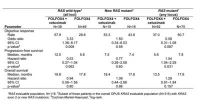(Press-News.org) CAMBRIDGE, MA -- Optogenetics, a technology that allows scientists to control brain activity by shining light on neurons, relies on light-sensitive proteins that can suppress or stimulate electrical signals within cells. This technique requires a light source to be implanted in the brain, where it can reach the cells to be controlled.
MIT engineers have now developed the first light-sensitive molecule that enables neurons to be silenced noninvasively, using a light source outside the skull. This makes it possible to do long-term studies without an implanted light source. The protein, known as Jaws, also allows a larger volume of tissue to be influenced at once.
This noninvasive approach could pave the way to using optogenetics in human patients to treat epilepsy and other neurological disorders, the researchers say, although much more testing and development is needed. Led by Ed Boyden, an associate professor of biological engineering and brain and cognitive sciences at MIT, the researchers described the protein in the June 29 issue of Nature Neuroscience.
Optogenetics, a technique developed over the past 15 years, has become a common laboratory tool for shutting off or stimulating specific types of neurons in the brain, allowing neuroscientists to learn much more about their functions.
The neurons to be studied must be genetically engineered to produce light-sensitive proteins known as opsins, which are channels or pumps that influence electrical activity by controlling the flow of ions in or out of cells. Researchers then insert a light source, such as an optical fiber, into the brain to control the selected neurons.
Such implants can be difficult to insert, however, and can be incompatible with many kinds of experiments, such as studies of development, during which the brain changes size, or of neurodegenerative disorders, during which the implant can interact with brain physiology. In addition, it is difficult to perform long-term studies of chronic diseases with these implants.
Mining nature's diversity
To find a better alternative, Boyden, graduate student Amy Chuong, and colleagues turned to the natural world. Many microbes and other organisms use opsins to detect light and react to their environment. Most of the natural opsins now used for optogenetics respond best to blue or green light.
Boyden's team had previously identified two light-sensitive chloride ion pumps that respond to red light, which can penetrate deeper into living tissue. However, these molecules, found in the bacteria Haloarcula marismortui and Haloarcula vallismortis, did not induce a strong enough photocurrent — an electric current in response to light — to be useful in controlling neuron activity.
Chuong set out to improve the photocurrent by looking for relatives of these proteins and testing their electrical activity. She then engineered one of these relatives by making many different mutants. The result of this screen, Jaws, retained its red-light sensitivity but had a much stronger photocurrent — enough to shut down neural activity.
"This exemplifies how the genomic diversity of the natural world can yield powerful reagents that can be of use in biology and neuroscience," says Boyden, who is a member of MIT's Media Lab and the McGovern Institute for Brain Research.
Using this opsin, the researchers were able to shut down neuronal activity in the mouse brain with a light source outside the animal's head. The suppression occurred as deep as 3 millimeters in the brain, and was just as effective as that of existing silencers that rely on other colors of light delivered via conventional invasive illumination.
Restoring vision
Working with researchers at the Friedrich Miescher Institute for Biomedical Research in Switzerland, the MIT team also tested Jaws's ability to restore the light sensitivity of retinal cells called cones. In people with a disease called retinitis pigmentosa, cones slowly atrophy, eventually causing blindness.
Friedrich Miescher Institute scientists Botond Roska and Volker Busskamp have previously shown that some vision can be restored in mice by engineering those cone cells to express light-sensitive proteins. In the new paper, Roska and Busskamp tested the Jaws protein in the mouse retina and found that it more closely resembled the eye's natural opsins and offered a greater range of light sensitivity, making it potentially more useful for treating retinitis pigmentosa.
This type of noninvasive approach to optogenetics could also represent a step toward developing optogenetic treatments for diseases such as epilepsy, which could be controlled by shutting off misfiring neurons that cause seizures, Boyden says. "Since these molecules come from species other than humans, many studies must be done to evaluate their safety and efficacy in the context of treatment," he says.
Boyden's lab is working with many other research groups to further test the Jaws opsin for other applications. The team is also seeking new light-sensitive proteins and is working on high-throughput screening approaches that could speed up the development of such proteins.
INFORMATION:
The research at MIT was funded by Jerry and Marge Burnett, the Defense Advanced Research Projects Agency, the Human Frontiers Science Program, the IET A. F. Harvey Prize, the Janet and Sheldon Razin '59 Fellowship of the MIT McGovern Institute, the New York Stem Cell Foundation-Robertson Investigator Award, the National Institutes of Health, the National Science Foundation, and the Wallace H. Coulter Foundation.
Noninvasive brain control
New light-sensitive protein enables simpler, more powerful optogenetics
2014-06-29
ELSE PRESS RELEASES FROM THIS DATE:
Bending the rules
2014-06-29
(Santa Barbara, Calif.) — For his doctoral dissertation in the Goldman Superconductivity Research Group at the University of Minnesota, Yu Chen, now a postdoctoral researcher at UC Santa Barbara, developed a novel way to fabricate superconducting nanocircuitry. However, the extremely small zinc nanowires he designed did some unexpected — and sort of funky — things.
Chen, along with his thesis adviser, Allen M. Goldman, and theoretical physicist Alex Kamenev, both of the University of Minnesota, spent years seeking an explanation for these extremely puzzling effects. ...
Improved method for isotope enrichment could secure a vital global commodity
2014-06-29
AUSTIN, Texas — Researchers at The University of Texas at Austin have devised a new method for enriching a group of the world's most expensive chemical commodities, stable isotopes, which are vital to medical imaging and nuclear power, as reported this week in the journal Nature Physics. For many isotopes, the new method is cheaper than existing methods. For others, it is more environmentally friendly.
A less expensive, domestic source of stable isotopes could ensure continuation of current applications while opening up opportunities for new medical therapies and fundamental ...
Improved survival with TAS-102 in mets colorectal cancer refractory to standard therapies
2014-06-28
The new combination agent TAS-102 is able to improve overall survival compared to placebo in patients whose metastatic colorectal cancer is refractory to standard therapies, researchers said at the ESMO 16th World Congress on Gastrointestinal Cancer in Barcelona.
"Around 50% of patients with colorectal cancer develop metastases but eventually many of them do not respond to standard therapies," said Takayuki Yoshino of the National Cancer Centre Hospital East in Chiba, Japan, lead author of the phase III RECOURSE trial. "The RECOURSE study shows that TAS-102 improves overall ...
Cetuximab or bevacizumab with combi chemo equivalent in KRAS wild-type MCRC
2014-06-28
For patients with KRAS wild-type untreated colorectal cancer, adding cetuximab or bevacizumab to combination chemotherapy offers equivalent survival, researchers said at the ESMO 16th World Congress on Gastrointestinal Cancer in Barcelona.
"The CALGB/SWOG 80405 trial was designed and formulated in 2005, and the rationale was simple: we had new drugs --bevacizumab and cetuximab-- and the study was designed to determine if one was better than the other in first-line for patients with colon cancer," said lead study author Alan P. Venook, distinguished Professor of Medical ...
Herpes virus infection drives HIV infection among non-injecting drug users in New York
2014-06-27
HIV and its transmission has long been associated with injecting drug use, where hypodermic syringes are used to administer illicit drugs. Now, a newly reported study by researchers affiliated with New York University's Center for Drug Use and HIV Research (CDUHR) in the journal PLOS ONE, shows that HIV infection among heterosexual non-injecting drug users (no hypodermic syringe is used; drugs are taken orally or nasally) in New York City (NYC) has now surpassed HIV infection among persons who inject drugs.
The study, "HSV-2 Co-Infection as a Driver of HIV Transmission ...
Potential Alzheimer's drug prevents abnormal blood clots in the brain
2014-06-27
Without a steady supply of blood, neurons can't work. That's why one of the culprits behind Alzheimer's disease is believed to be the persistent blood clots that often form in the brains of Alzheimer's patients, contributing to the condition's hallmark memory loss, confusion and cognitive decline.
New experiments in Sidney Strickland's Laboratory of Neurobiology and Genetics at Rockefeller University have identified a compound that might halt the progression of Alzheimer's by interfering with the role amyloid-β, a small protein that forms plaques in Alzheimer's brains, ...
'Bad' video game behavior increases players' moral sensitivity
2014-06-27
BUFFALO, N.Y. — New evidence suggests heinous behavior played out in a virtual environment can lead to players' increased sensitivity toward the moral codes they violated.
That is the surprising finding of a study led by Matthew Grizzard, PhD, assistant professor in the University at Buffalo Department of Communication, and co-authored by researchers at Michigan State University and the University of Texas, Austin.
"Rather than leading players to become less moral," Grizzard says, "this research suggests that violent video-game play may actually lead to increased moral ...
Ancient ocean currents may have changed pace and intensity of ice ages
2014-06-27
Climate scientists have long tried to explain why ice-age cycles became longer and more intense some 900,000 years ago, switching from 41,000-year cycles to 100,000-year cycles.
In a paper published this week in the journal Science, researchers report that the deep ocean currents that move heat around the globe stalled or may have stopped at that time, possibly due to expanding ice cover in the Northern Hemisphere.
"The research is a breakthrough in understanding a major change in the rhythm of Earth's climate, and shows that the ocean played a central role," says ...
Research gives unprecedented 3-D view of important brain receptor
2014-06-27
PORTLAND, Ore. — Researchers with Oregon Health & Science University's Vollum Institute have given science a new and unprecedented 3-D view of one of the most important receptors in the brain — a receptor that allows us to learn and remember, and whose dysfunction is involved in a wide range of neurological diseases and conditions, including Alzheimer's, Parkinson's, schizophrenia and depression.
The unprecedented view provided by the OHSU research, published online June 22 in the journal Nature, gives scientists new insight into how the receptor — called the NMDA receptor ...
Study: To address climate change, nothing substitutes for reducing CO2 emissions
2014-06-27
The politically expedient way to mitigate climate change is essentially no way at all, according to a comprehensive new study by University of Chicago climatologist Raymond Pierrehumbert.
Among the climate pollutants humans put into the atmosphere in significant quantities, the effects of carbon dioxide (CO2) are the longest-lived, with effects on climate that extend thousands of years after emissions cease. But finding the political consensus to act on reducing CO2 emissions has been nearly impossible. So there has been a movement to make up for that inaction by reducing ...
LAST 30 PRESS RELEASES:
School meals could unlock major gains for human and planetary health
Menopause hormone therapy does not appear to impact dementia risk
Signature patterns of brain activity may help predict recovery from traumatic brain injury
Dresden study uncovers new key mechanism in cancer cells
New species are now being discovered faster than ever before, study suggests
Cannabis-based products show limited short-term benefit for chronic pain, with increased risk of adverse effects
Cannabis products with more THC slightly reduce pain but cause more side effects
Clearing the brain of aging cells could aid epilepsy and reduce seizures
Brain injuries linked with potential risk of suicide, new study finds
New technique lights up where drugs go in the body, cell by cell
New study finds movement of fishing fleets can reveal shifts in marine ecosystems
Embargoed: New evidence points to potential treatment for vascular dementia
Study uncovers disrupted brain balance in alcohol dependence
Working in groups can help Republicans and Democrats agree on controversial content moderation online
Structural findings reveal how distinct GPCR ligands create different levels of activation
Anything-goes “anyons” may be at the root of surprising quantum experiments
UC review: Maximizing workplace opportunity for veterans
From generation to complex control: Metasurfaces make perfect vortex beams "within reach"
Thin-film lithium niobate-based detector: recent advances and perspectives
Exploring why some people may tend to persistently make bad choices
How cells balance their protein levels
Nirsevimab vs RSVpreF vaccine for RSV–related hospitalization in newborns
Effectiveness and impact of maternal RSV immunization and nirsevimab on medically attended RSV in US children
AI gives scientists a boost, but at the cost of too many mediocre papers
Next-generation vision model maps tree growth at sub-meter precision
Genes aren’t destiny for inherited blindness, study shows
MIT study: High-fat diets make liver cells more likely to become cancerous
Exposure to multiple fine particulate matter components and incident depression in the US Medicare population
Risk of burdensome health care spending over time in the US
Nirsevimab against hospitalizations and emergency department visits for lower respiratory tract infection in infants
[Press-News.org] Noninvasive brain controlNew light-sensitive protein enables simpler, more powerful optogenetics





